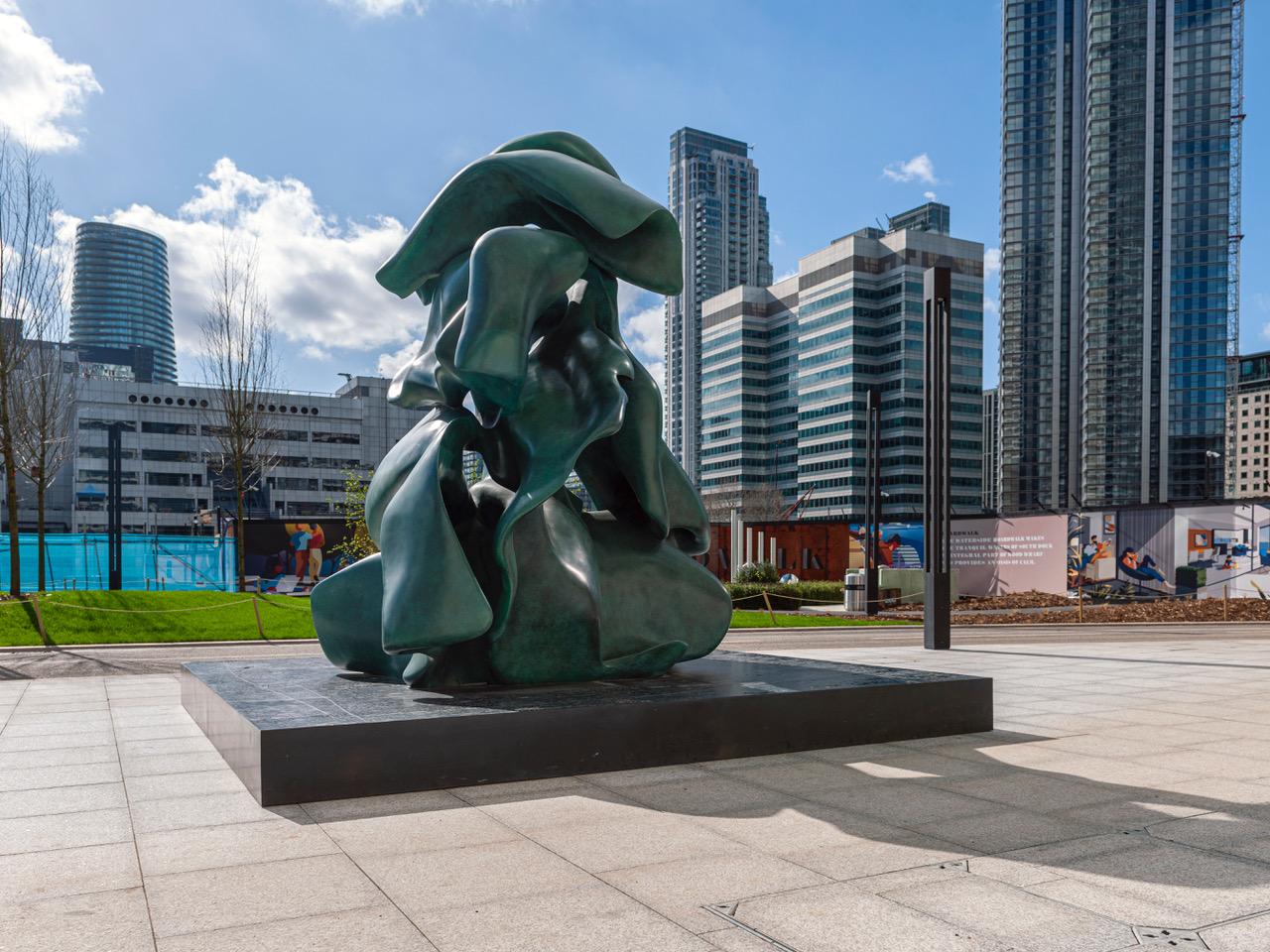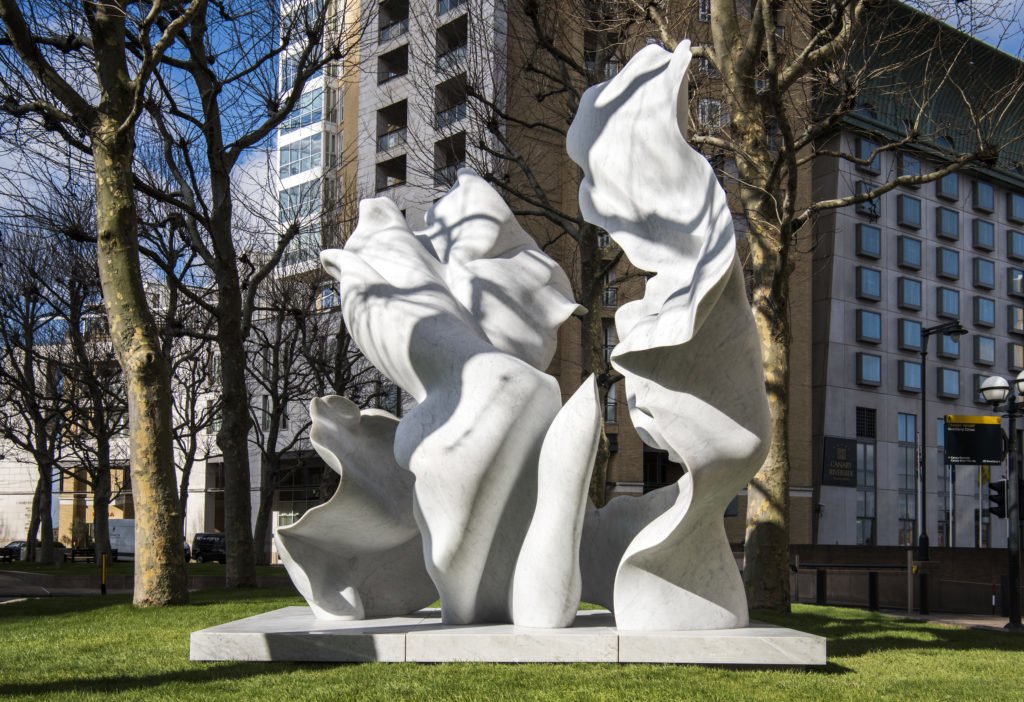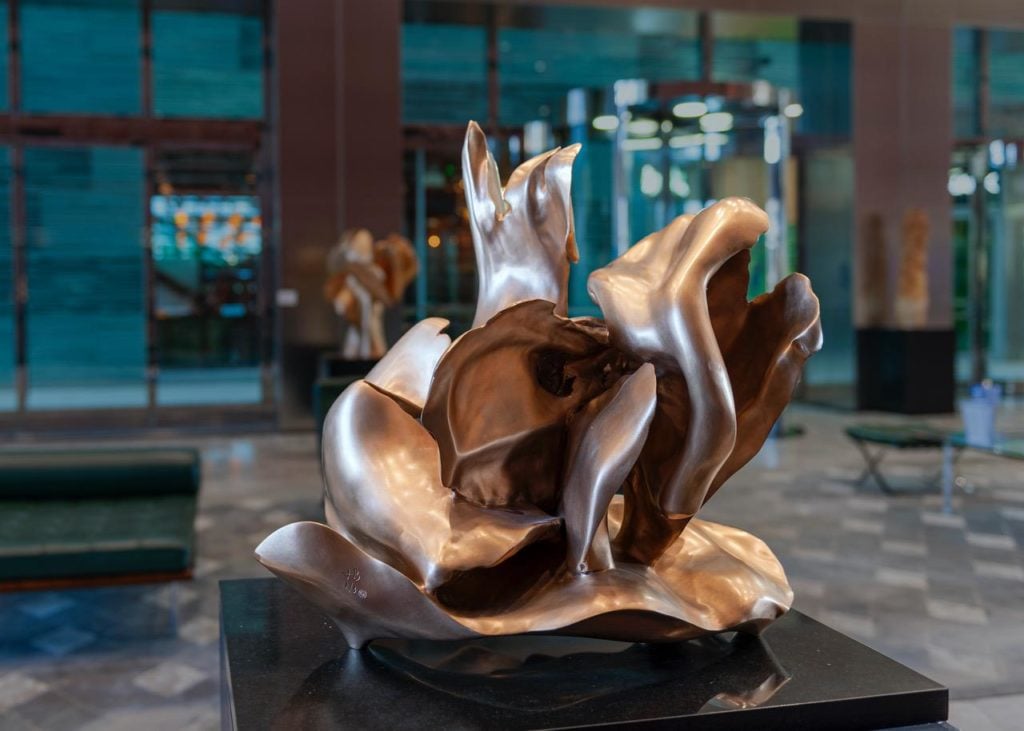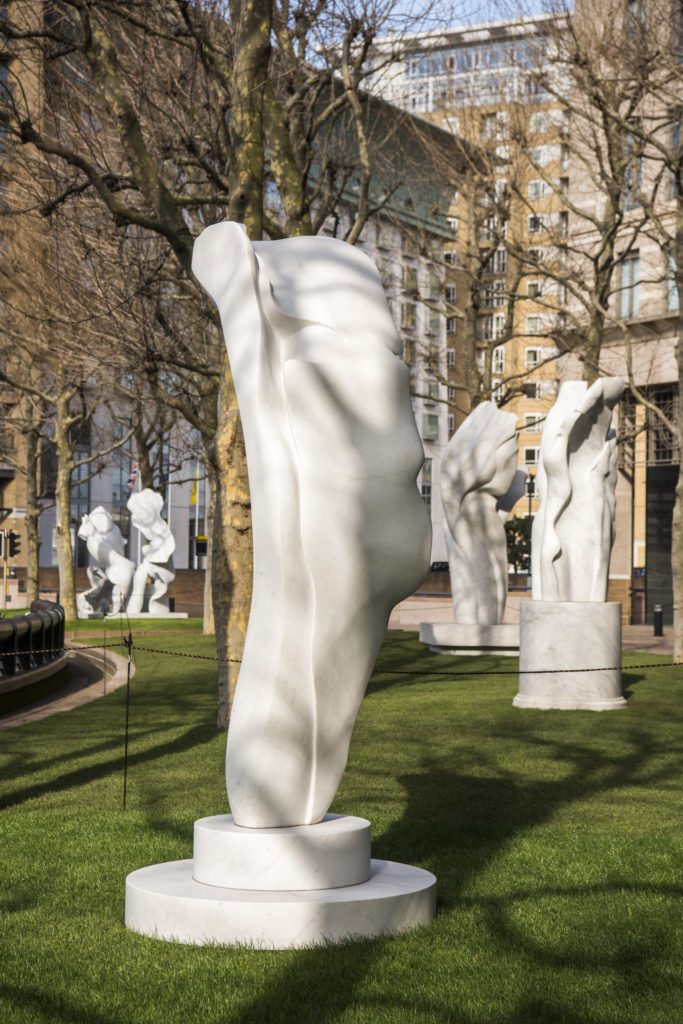Press

Helaine Blumenfeld: Undulating Structures – Interview
ArtlystHelaine Blumenfeld is Best known for her monumental public commissions, such as the five-metre bronze sculpture ‘Fortuna’ that in 2016 was added to the Canary Wharf Group’s permanent art collection, Blumenfeld is passionate about bringing sculpture into the public domain. For this reason, it is particularly appropriate that her current exhibition Looking Up is in the public spaces of Canary Wharf, both external and internal.
‘Fortuna’ has been joined in Jubilee Park by three other works ‘Venus’, ‘Flight’ and ‘Ascent’. The Canary Wharf Group has also commissioned a four-metre monumental bronze sculpture ‘Metamorphosis’, which is at Wood Wharf, Canary Wharf’s new district. Also externally located are other key works such as ‘Taking Risks’, a new monumental three-part sculpture exploring the versatility, fluidity and translucency of marble, and ‘Illusion’, three inter-related bronze pieces that evoke the chaos of the contemporary world creating a dual sense of foreboding and hope.
An indoor exhibition at One Canada Square features more than twenty sculptures, including seven new works created especially for this space. ‘Toward The Precipice’ is carved in marble and exhibits feelings of tension, its dynamism contrasting with other more effusive, expansive works. Sculptures from Blumenfeld’s acclaimed ‘Exodus’ series can also be found together with two exquisitely carved pieces in cedarwood standing more than two and a half metres high – ‘Flight’ and ‘Aurora’.
Blumenfeld has developed a practice inspired by Cycladic sculpture and Futurism, creating a sculptural vocabulary, in a zone between abstraction and figuration, that is entirely her own. Testing the limits of the materials in which she works, she plays with duality, introducing a remarkable lightness to carved stone. Her profound understanding of the boundaries of her materials enables the creation of impossibly thin, undulating structures which possess a magical luminosity.
As Looking Up and an accompanying exhibition, Intimacy at the Hignell Gallery, which is yet to open because of the Covid-19 lockdown, clearly show her themes have remained consistent throughout her fifty-year career. Still, her exploration of those themes has changed.
Initially, Helaine Blumenfeld explored Intimacy as knowledge of oneself, expressed in individual, abstract forms. The theme was then extended to examining the dynamics of relationships, changes from movement and potential for tension, cooperation and growth. Her sculptures are now rooted in an interest in what it means to be connected and to share perspectives. Her most recent work explores the significance of humanity and community in the challenging times in which we live, poetically reflecting optimism in humankind and belief in finding unity within differences.
Blumenfeld is concerned that society is at a precipice, and the pieces in these exhibitions call out for regeneration. I asked her first about the impact the Covid-19 lockdown has had on the exhibitions themselves.

JE: What are your personal hopes for these exhibitions, given the unexpected circumstances of the Covid-19 outbreak?
HB: Initially, my main hope was that we could get all the work in place – the ten monumental sculptures outside in the parks and 30 sculptures in the lobby of One Canada Square. Many people helped, and it felt like a miracle to get it done, particularly as the new work was coming from Italy around the time borders were beginning to be closed. We just about made it, and there were ten days in which people could see it before lockdown. I’ve received a significant number of emails saying how much it has meant to them; saying my work has given them comfort or hope.
The work will be there for quite a long time, but even if it is only seen by a thousand, rather than tens of thousands, it will be worth it if those people gain a sense of humanity through the work. There are plans to put the exhibition online. A slide show of the exhibition has already been placed on YouTube by the city of Pietrasanta where I work in Italy with tremendous numbers viewing it already.
It is a very timely show. Over the past months, I have felt increasingly concerned that society was moving towards a precipice caused by isolation, lack of empathy, the breakdown in trust, and absence of leadership. I had planned to call the show Towards the Precipice. Many of the works in the show depict broken edges, reflecting this. However, ultimately I felt Looking Up was a title that more clearly represented what I wanted to communicate. This is an incredibly important time when we will either learn to empathise, cooperate or connect, or we will have failed the challenge in front of us.
What will we learn for the future? The show is both warning and antidote, as the majority of pieces show connection and relationship. That is how we can come out of this; through the community, spiritual values, and acknowledgement that we are all human. We will have to look at the world differently. By looking up, we can see a spiritual dimension. We need to acknowledge the crisis of our climate, which is even more terrifying than the virus, but less immediately tangible. As a result of the pandemic, we are seeing that climate issues, which we thought would take decades to address, are being solved.

Jonathan Evens: ‘Illusion’ is an image of three abstracted figures supporting one another in the challenging times in which we live. Is there a sense that lockdown emphasises the importance of Intimacy as a central theme in your work?
Helaine Blumenfeld: Technology gives us the tools to be connected yet we seem to be isolated as never before. I worry that no global effort is being made to bring peoples together to address the pandemic. Yet the pandemic is forcing families to spend time together, use phones to hear voices, giving the energy to applaud NHS workers. So, there is a learning curve.
Public art becomes part of daily life. Before lockdown, the 250,000 who work in Canary Wharf were gathering, as individuals and in groups, around these sculptures, going onto the bases and inside to hold, touch and feel supported.
JE: At One Canada Square, the organic flowing curves of your sculptures contrast with the strict lines and clean angles of the building. Was this part of the attraction of exhibiting in such a space?
HB: Art mediates between the impenetrability of geometric buildings and the people who use them. Working on an early commission in Milwaukee, I reflected on the effect of several huge sculptures already in place. Seeing people actively avoid those sculptures, I decided to work on a scale to which people could relate; intimate pieces. Public sculpture can give people a sense of belonging and mediate the enormity of public buildings.
JE: You have described seeing a vision of a tree trunk that moved upward and opened into a panoply of branches with regrowth of blossoms, and clouds of many leaves, creating a sense of hope. This vision led to your first ‘Tree of Life’ sculpture. Presumably, the title of this exhibition Looking Up also derives from that vision. In what ways do you hope your show will be a sign of hope in these dark days?
HB: ‘Looking up’ is a fundamental concept in my work. All my work is about aspiration, reaching upwards and overcoming difficult moments. I like to encourage people to focus their perspective beyond their immediate circumstances toward other possibilities and growth. The Tree of Life theme was one manifestation of this idea.
JE: Looking upwards seems to imply stopping – we look down when we walk. Does your title suggest the sense of contemplation that your images achieve?
HB: On the opening day of the exhibition, I saw people pausing and reflecting on the work and the world. That is what I had hoped for. Joseph Campbell spoke of art as a revelation. If we can approach a work of art open to its effect, we can have a revelation. The work can talk to you when you look with your mind and emotions as the artist does when creating. When I exhibited at Salisbury Cathedral and Ely Cathedral, I discovered that visitors were more openly affected by my sculptures, more so than visitors at a gallery or museum. We need art in public spaces to give people that experience in daily life.

JE: ‘Taking Risks’ is a new, monumental three-part sculpture carved from Carrara marble. In what ways are you taking risks with your materials and testing the limits of those materials as you work?
HB: I was taking risks with the materials, particularly in the ragged edges, which are very thin. I tested the gravity of the piece. I took risks with the form of the piece, with the marble, but also with the concept; as the key to growth is taking risks. I think that we often don’t push ourselves enough as human beings. When we stand still and take no risks, there is no growth.
The pieces of mine to which people most immediately respond are those, like ‘Meridiana’ and ‘Flight’, which are iconic, ascending, upright. Perhaps, our idea of beauty has become too simple. The more complex works, like ‘Taking Risks’, are beautiful because we need to give ourselves over to them; to go around and inside to see relationships between the figures and the spaces.
JE: Your works incorporate blemishes of pigmentation and flaws into the smoothness of the surfaces so that we can see that these pieces are not realisations of perfection, but are fashioned from struggle. Could you say more about the tension between the finished and the flawed in your work?
HB: I wouldn’t say that I incorporate flaws into the work. I create areas of roughness and smoothness to communicate tension and struggle.
‘Fortuna’ is an example. In its broken surfaces, I was trying to show a sense of raw energy pushing from the inside out. In society, we have so many layers that protect us, but they also limit us. We need to break the shell to expose ourselves and grow. This struggle is expressed in my work in the form of surface scars. I try to confront reality and then mediate it by creating beauty, perspective and proportion.
JE: Has ‘Fortuna’, your 2016 commission for Jubilee Park, changed in any way in the years since its installation as a result of the thousands that have viewed and interacted with it?
HB: Jubilee Park was a temporary site for ‘Fortuna’ but, once there, people quickly identified the space by the sculpture – using it as a location for meeting one another or for sharing picnics. It showed me how people can change their daily routine through public art; loving it and touching it. It was overwhelming to me to see how people came to use this area. It quickly became their sculpture and those who had commissioned it decided it should stay and even commissioned another sculpture for the original planned location.
Another commissioned work in the US increased in value to the extent that the new owners of the site decided to sell it. But local people viewed it as their sculpture and congregated around it in protest. The sculpture had created a community that was sufficient to prevent its sale and which renamed the five movable pieces, ‘The Family’.
JE: This show presents a diverse selection of your sculptures dating from the 1970s, tracing your development through some forty-six years. Looking at this show, how do you think your work has changed and is changing?
HB: The ideas haven’t changed so much, but my ability to carry them out has changed. My work is now lighter and more translucent. The early pieces are an expression of what I was able to achieve at the time.
JE: You have spoken of public art connecting the physical space people find themselves into the spiritual space they might enter. Is this a time in which, more than any other, we need to transcend our perspectives and, in your own words, revive belief in something higher and more meaningful than material success?
Helaine Blumenfeld: Yes, this is the reason for doing this show. I believe more than ever to get beyond the precipice at which we find ourselves; we need to find ways to transcend the limits of our own perspective. Intimacy is lacking on a global level. We need to have a profound knowledge of each other to empathise and develop an increased sense of community. We must learn to connect with each other on a human scale. Engaging with art can help us to do this.
Looking Up: Helaine Blumenfeld at Canary Wharf, One Canada Square and throughout Canary Wharf.